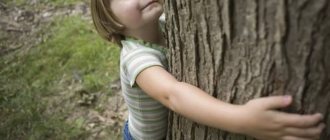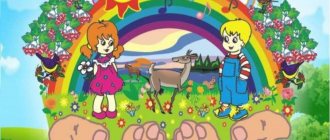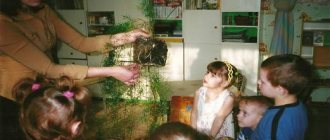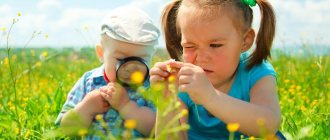“Environmental education of preschool children taking into account the Federal State Educational Standards for Preschool Education” article on the world around us on the topic
Environmental education of preschool children taking into account the Federal State Educational Standard of Education
The tasks set by the Federal State Educational Standard for preschool pedagogy are aimed at the end result - the formation of an integral spiritual and moral personality. One of the important aspects of this process is environmental education. Only a person who sincerely loves his land, his native land will grow up to be a true patriot of his Motherland. How is environmental education implemented in kindergarten?
Environmental education in preschool educational institutions
Environmental education of preschoolers according to the Federal State Educational Standard for Education is a continuous process of children’s development aimed at developing an environmental culture in them, which is expressed in the presence of:
- sustainable knowledge about nature and the relationships existing in it;
- respect for nature;
- correct understanding of the concept of “healthy lifestyle”;
- moral and environmentally valuable attitudes, behavioral skills;
- emotional responsiveness to living nature;
- positive aesthetic feelings from admiring nature;
- skills to understand the features of the surrounding world.
The issues of implementing environmental education in preschool educational institutions are especially important. After all, it is precisely at the age of 3-5 years that the foundations of a person’s perception of the world are laid. On the other hand, a child’s knowledge of nature is an important factor in the educational process.
Environmental education of preschool children, taking into account the Federal State Educational Standard, can be implemented through the following types of activities:
- observations;
- experiments;
- research;
- games;
- work;
- artistic and aesthetic practice;
- acquaintance with natural history literature;
- physical education and sports.
An important point is the need to implement environmental education in two directions:
- during training sessions;
- in everyday life.
It is necessary to strive, as far as possible, to consolidate the theoretical knowledge acquired in the classroom in the process of subject-transforming activities in nature. Children should be involved in caring for plants and animals and maintaining a favorable environmental environment. As a result, preschoolers develop personal experience of influencing nature, their cognitive interests are activated, and the need for activities in nature is formed.
Forms of environmental education
A kindergarten teacher has a wide range of forms of implementing environmental education: collective; group; individual.
Among the collective forms, the most popular are the environmental holidays “Gifts of Nature”, “Autumn Ball”, “Hello Summer”, “Oh, winter-winter”, etc. Joint labor activities in cleaning and landscaping the territory, working in flower beds and plots are also often practiced. Children need to be involved in trainings, kindness lessons, environmental marathons and festivals.
Group forms of work include excursions, research and experiments. An effective type of group work is to involve children in developing projects. In addition, for small groups of students it is recommended to organize events such as performances by a propaganda team, role-playing games, activities of environmental groups or clubs, and participation in environmental actions.
Nature observations are organized on an individual basis. Positive emotions are evoked in children by such types of individual activities as participation in competitions, artistic and aesthetic activities: making crafts, modeling, creating drawings, etc.
Special attention should be paid to the existing forms of interaction with parents:
- consultations;
- competitions;
- family meetings;
- exhibitions of children's works;
- methodological bulletins;
- holidays.
The participation of parents in joint work with children increases the interest of preschoolers in the task, helps to establish contact between family members, bring them closer together emotionally, and contributes to the formation of an environmental culture in adults. The main thing is to interest parents in such activities and offer them personally relevant environmental information.
Methods of environmental education for preschool children
When determining the most effective methods of environmental education for preschool children, taking into account the Federal State Educational Standard for Education, preference should be given to playful, visually effective and project-based ones.
Observation
The main method of environmental education is observation. It allows for sensory cognition of natural objects. All forms of perception can be involved.
Most often, preschoolers are asked to observe the state of nature and the life of plants. Such observations should be carried out regularly throughout the year. This type of work is a mandatory element of daily walks. In addition, birds, domestic animals and insects are periodically observed. About 1-2 times a month, children observe social objects and the peculiarities of adult work.
When organizing surveillance, it is important to follow the following rules:
- the object of observation must be accessible to perception;
- observation time should be 5-10 minutes;
- it is necessary to take into account the age and individual characteristics of children, their interests.
The main thing is that observation is not an end in itself. It is necessary that this process be multi-stage:
- perception of natural objects;
- study of the characteristics of a given object, its relationship with other objects or phenomena;
- creative display of received information.
The teacher must guide the activities of preschoolers in the process of observation, ask questions, and set problematic tasks for them. The main thing is to evoke an emotional response in children and a desire to continue such activities on their own.
A game
The game provides children with freedom of action, freedom and the opportunity to take initiative. However, to use gaming activities in the process of environmental education, it is necessary to organize them in such a way that there is no threat or harm to wildlife.
An obligatory attribute of children's life are toys that depict natural objects. By playing with them, preschoolers imitate the habits and lifestyle of animals.
A separate type of work on environmental education is the manufacture of toys from natural materials. Children will become familiar with the characteristics of natural objects, and the fact that as a result of such an activity a beautiful, bright toy will be obtained increases interest in these activities.
In kindergarten, story games, practical games, and illustration games are practiced. It is very useful to offer children practical games with objects such as sand, water, clay. The purpose of these games is not only to have fun and make a figurine or make a house (splash with water, blow bubbles, etc.), but also to learn the properties of these natural materials.
Project activities
An excellent way to combine a variety of activities aimed at understanding the world around us is the project method. It provides for preschoolers to carry out practical, purposeful activities and contributes to the formation of their personal life experience in interacting with natural objects.
Working on a project gives the child the opportunity to consolidate theoretical knowledge, feel like a tester, and participate “on an equal footing” with adults in joint cognitive activities. With preschoolers you can implement research, practice-oriented, role-playing, and creative projects. These are usually short-term group or individual projects.
Creation of an ecological environment
An important educational aspect that influences the formation of environmental culture in preschool children is the creation of a favorable ecological environment in kindergarten. This is a continuous process that involves organizing a special ecological space and carrying out regular actions aimed at maintaining the conditions necessary for living nature in it.
The most common types of this form of work are creating a “living corner”, growing indoor flowers, and decorating a flower bed. The educational effect will be achieved only if children do not just observe animals and plants, but take an active part in caring for them.
The relevance of environmental problems in modern society brings issues of environmental education to the forefront. In a preschool institution, an important task is being solved - not only to reveal the beauty of nature to children, but also to teach them to notice and appreciate it on their own.
Goals and objectives of environmental education in preschool educational institutions
Preschool age is a unique period in the formation and development of a child. A properly organized upbringing process has a productive effect on the overall development of the child and creates the prerequisites for his further upbringing and education.
Are you an expert in this subject area? We invite you to become the author of the Directory Working Conditions
The general goal of raising preschool children is the full, comprehensive and harmonious development of the child’s personality.
It is very difficult to identify a single goal of environmental education for preschool children, since environmental education is a continuous process that begins from preschool age and continues throughout life.
Note 2
According to the Federal State Educational Standard for Preschool Education, the goal of environmental education for preschool children is the implementation by preschool teachers of a continuous, purposeful, controlled process to develop an environmental culture in children.
Elements of ecological culture of preschool children are:
- respect for the environment
- sustainable knowledge about the surrounding world and the interconnection of all living things
- correct understanding of a “healthy lifestyle” (HLS)
- moral attitudes and ideas about environmental values
- emotional responsiveness to nature and its phenomena
- positive feelings and sensations from communication with the surrounding nature
- desire to explore and learn about the world around us
Finished works on a similar topic
Coursework The purpose and objectives of environmental education 430 ₽ Abstract The purpose and objectives of environmental education 260 ₽ Examination The purpose and objectives of environmental education 240 ₽
Receive completed work or specialist advice on your educational project Find out the cost
The goal of environmental education of preschool children, specified in the Federal State Educational Standard for Preschool Education, is achieved by solving its main tasks:
- Educational objectives:
- formation of a holistic system of knowledge about current environmental problems of the world
learning ways to solve environmental problems
- acquisition of knowledge on the prevention of environmental problems
- Educational tasks:
- formation of motives, habits and needs for environmental behavior
formation of a healthy lifestyle throughout life, a negative attitude towards bad habits
- development of the need for a healthy lifestyle and compliance with environmental rules of behavior
- Developmental tasks:
- development of a system of theoretical and practical knowledge, skills and abilities aimed at studying and assessing the state of the environment
development of skills to preserve and improve the state of the environment.
Let's decide together
Can't enroll your child in kindergarten? Would you like to tell us about the teachers? Do you know how to improve your diet and exercise?
Municipal budgetary preschool educational institution, kindergarten of general developmental type No. 11 “Firefly” of the Municipal Entity Timashevsky District (MBDOU d/s No. 11) was opened in 1966.
If there is an island of love, joy, and happiness on Earth, then this is MBDOU d/s No. 11 “Firefly”. Our preschool educational institution is a living organism that breathes, feels, and rejoices. We try to penetrate every child's heart, instill in it joy, love, kindness. Preschool educational institutions are parents. They are the main assistants in our work and we are very grateful to them for this. Preschool educational institutions are employees. The most hardworking, creative people who can do everything, who care about everything with their souls, who love children. A preschool is a big family. And like any friendly family, we have our own traditions. If you want your baby to feel comfortable, to develop in accordance with his capabilities and abilities, come to us at the Firefly kindergarten.
The preschool educational institution operates in accordance with the Federal Law “On Education in the Russian Federation”. A license was issued for the right to carry out educational activities under educational programs dated March 12, 2013 No. 05353. The preschool educational institution has a license to carry out medical activities dated December 5, 2012 No. LO-23-01-005240.
The preschool educational institution ensures a high level of development of preschool children in accordance with their age and individual characteristics. Contributes to the preservation of physical and mental health, intellectual, artistic and aesthetic, social and moral development, emotional comfort of the child and his socialization.
The preschool educational institution works according to the “Basic general educational program of preschool education.”
In addition to the basic forms, teachers use new methods, technologies, and partial programs in their work:
- “Education of ecological culture among preschool children” (S.N. Nikolaeva)
“Fundamentals of the safety of preschool children” (R.B. Sterkina,)
MAIN TASKS OF EDUCATION AND TRAINING IN KINDERGARTEN:
- protecting the lives and strengthening the physical and mental health of children;
- ensuring the intellectual, personal and physical development of the child;
- introducing children to universal human values;
- interaction with the family to ensure the full development of the child.
PRIORITY DIRECTIONS:
- protecting the lives and strengthening the physical and mental health of children
- artistic and aesthetic education of children;
- interaction with the family to ensure the full development of the child.
The teachers will make sure that your child becomes independent, sociable, active, inquisitive, learns to think, develops his creative abilities, joins the world of art, and learns to create his own artistic creations; musical director L.E. Chernyavskaya will reveal the talents of your baby and he will become a real little artist; work on moral and patriotic education is carried out, skills and abilities in visual arts are improved, taking into account the age characteristics of children. Work is underway on environmental education in all groups, there is an environmental classroom “Ladybug” in which senior students conduct experiments and experiments, based on the developments of the programs “Young Ecologist” by S.N. Nikolaeva and “Our Home is Nature” by N.A. Ryzhova. Children develop a conscious attitude towards natural phenomena, towards themselves and their health. At the preschool educational institution a complex of health-improving and educational activities is carried out, the basis of which is motor activity, these are: physical education classes; physical education and health work during the day (morning exercises, physical education minutes, outdoor games and physical exercises, hardening activities, gymnastics after sleep, “health paths”); active recreation (physical education and holidays, health days, vacations); health services: phytoncidotherapy.
We provide additional development of children’s individual abilities in the “Bell” - vocal circle.
Pedagogical principles of the team:
We raise friendly, cheerful and resourceful people. We warm you with affection, warmth, care. We develop healthy, strong, dexterous people. We sow reasonable, good, eternal things.
Every child in our garden is a clear star. And this star shines brighter because she knows that she is loved and valued, knows that she will not be abandoned, but will be helped to achieve perfection.
Dear mothers and fathers, grandparents!
We are glad to welcome you to our website!
Why did we open our website on the Internet?
In order to tell more about the preschool institution, which has become a second home for us, about the kind and creative employees who give a piece of their soul and warmth to our dear students, as well as about the children themselves, whose upbringing and education we consider the most important activity. We strive to ensure that the preschool educational institution is for everyone who visits it a home in which comfort, coziness and kindness reign, where music and sonorous children's laughter are heard, a home to which they come with joy.
On this website you can get all the necessary information about the life of our kindergarten.
You can find out information about how we live. We will talk about past events and significant dates. You can look at our photo album and learn from us some experience in conducting classes and consultations.
- In the “Guest Book” section you can contact us and leave wishes and comments on the work of the preschool educational institution in general, as well as get acquainted with the opinions of other parents;
- The “Kindergarten Events” and “News” sections contain notes of classes and events conducted by our teachers;
- The “Garden Tour” section contains photographic materials of the territory of the preschool educational institution, interesting events held in the preschool educational institution, etc.;
- In the “Information for Parents” section you will find a lot of interesting things: games, poems, songs, riddles and much more;
- In the “Recommendations from Experts” section you can find consultations for educators and parents.
We hope that our site will be useful to both parents of pupils of our preschool educational institution and many others. If you have questions regarding MBDOU d/s 11, you can ask them to our email address.
We are waiting for you at:
Krasnodar region, Timashevsk microdistrict. Sugar factory 8.
tel./fax: 8 (86130) 5-35-77
Sincerely, Head of MBDOU d/s No. 11 Avramenko Tatyana Andreevna
Goals and objectives of environmental education at school
Note 3
The main goal of environmental education at school is the formation and development of environmental culture and environmental competencies in children.
Environmental education of schoolchildren is aimed at transferring the environmental experience of the older generation. However, this is not always enough for environmental education to be complete and effective. In order to achieve this goal, the student must be an active participant in the educational process and influence his elders and peers.
It should be noted that the environmental goals of education at school are different, depending on the age of the children.
Goals of environmental education of children in primary school:
- fostering a caring and respectful attitude towards the environment
- development of a sustainable desire to observe moral principles in the process of relationships with nature and when using natural resources
- promotion of environmental goals
- engaging in active activities to study the rules of treating nature and how to protect it
The tasks of environmental education for primary school children are similar to the tasks of raising children in preschool educational institutions. However, in addition to educational, educational and developmental types of tasks, there are a number of specific tasks based on the age characteristics and needs of children of primary school age.
Objectives of environmental education in primary school:
- Educational and educational objectives: deepening and expanding existing environmental knowledge
- Behavioral tasks: developing initial environmental skills and abilities
- Cognitive tasks: development of cognitive, creative and social activity of children in the process of environmental activities
- Transformative tasks: aimed at fostering feelings of respect for nature.





